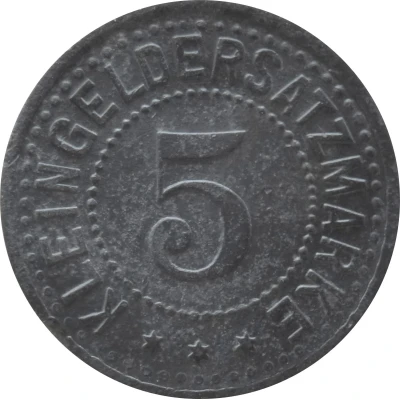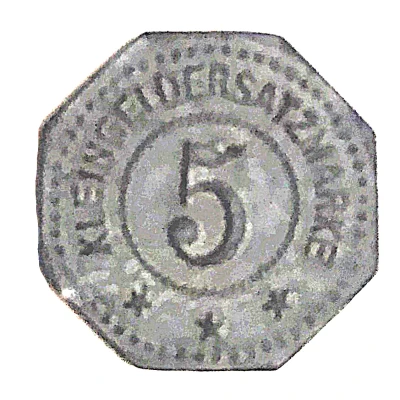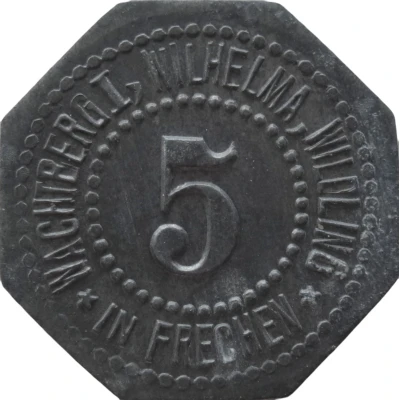


© Willem63 (CC BY-NC-SA)
5 Pfennigs - Duisdorf (Westdeutsche Porzellanfabrik) ND
| Zinc | 1.2 g | 18.1 mm |
| Issuer | German notgeld (Germany) |
|---|---|
| Type | Standard circulation coin |
| Value | 5 Pfennigs (5 Pfennige) (0.05) |
| Currency | Mark (1914-1924) |
| Composition | Zinc |
| Weight | 1.2 g |
| Diameter | 18.1 mm |
| Thickness | 0.9 mm |
| Shape | Round |
| Technique | Milled |
| Orientation | Medal alignment ↑↑ |
| Demonetized | Yes |
| Updated | 2024-10-04 |
| Numista | N#321524 |
|---|---|
| Rarity index | 97% |
Reverse
Pearl rim, legend surrounding pearl circle with denomination centered
Script: Latin
Lettering:
KLEINGELDERSATZMARKE
5
★ ★ ★
Edge
Plain
Comment
Menzel: BBBIn 1905 the brothers Carl and Eduard Schumann founded a porcelain factory in Duisdorf under the name Eduard Schumann Porzellanfabrik. The factory premises were located directly at the train station (Alter Heerweg 2). After the death of Eduard Schumann in 1907, Keramische Werke GmbH was founded in 1908 to continue operating the factory. The managing directors were the Bonn merchants Gustav Wahl and Andrew Bayerwaltes. In 1912, Keramische Werke GmbH was renamed Westdeutsche Porzellanfabrik GmbH. In 1935 the company with 200 employees filed for bankruptcy. The company was bought at auction and renamed Rhenania Porzellanfabrik GmbH. Sole owner was Georg Kettner. On June 30, 1958, the factory was closed due to outdated production facilities and a lack of successors. Utility and ornamental porcelain with blue underglaze decoration was made there: onion pattern and straw model. The factory became known in 1950 with the Eva tableware. The hotel tableware with the shape 85 received an award in 1954
Interesting fact
The 5 Pfennigs - Duisdorf (Westdeutsche Porzellanfabrik) ND coin from German notgeld (Germany) made of Zinc weighing 1.2 g is a rare and valuable coin among collectors due to its historical significance and limited mintage. It was produced during a time of economic crisis in Germany, specifically during the hyperinflation period of the 1920s, when the value of the German mark plummeted, and the government was forced to issue emergency currency, known as "notgeld," to address the issue. The coin's design features the image of a woman holding a shield with the city's coat of arms, symbolizing the city's resilience and determination to overcome the economic challenges of the time. Today, this coin is a sought-after collector's item, not only for its historical significance but also for its aesthetic appeal and rarity.



